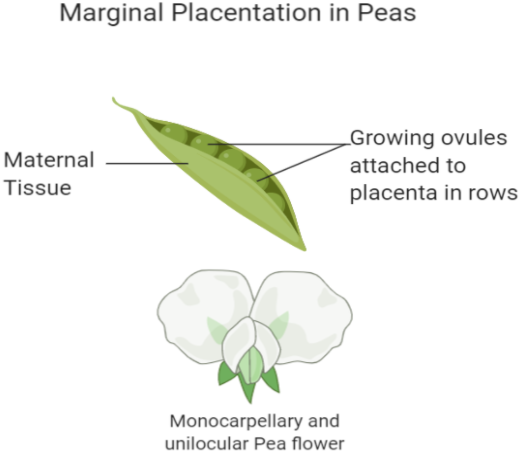
How many plants in the list given below have marginal placentation?
Mustard, Gram, Tulip, Asparagus, Arhar, Sum hemp, Chilli, Colchicine, Onion, Moong, Pea, Tobacco, Lupin.
A. Five
B. Six
C. Three
D. Four
Answer
564.9k+ views
Hint:
Complete step by step answer: The placentation in an ovary depicts the pattern of arrangement of its ovules. There are many types of patterns in which the ovules can be arranged. One of these patterns is called marginal placentation. In this type of placentation, the ovules are arranged or placed along two rows. The arrangement takes place below the surface of the ovary that is on its ventral side. The placenta forms a central margin over which the ovules are attached on both sides making two rows. This type of placentation is quite evident in peas. In peas, we see that when we open it, there is a central margin to which the peas are attached in two rows. Moreover, this type of placentation occurs in monocarpellary plants and unilocular ovaries. This means plants that have a single female reproductive unit and a single chamber inside the ovary respectively.

Now, let us see which of the given plants are monocarpellary and unilocular.
Gram, Arhar, Moong, Pea, Lupin, and Sun hemp are the plants that show marginal placentation as they are monocarpellary and unilocular.
Hence, the correct option is option B, i.e., Six.
Note: Placentation plays an important role in the ovary. It acts as a nutrient and waste transfer system for the growing seeds. It passes nutrients and water from the maternal tissue to ovules. Also, it helps in gaseous exchange and sometimes in waste removal.
Complete step by step answer: The placentation in an ovary depicts the pattern of arrangement of its ovules. There are many types of patterns in which the ovules can be arranged. One of these patterns is called marginal placentation. In this type of placentation, the ovules are arranged or placed along two rows. The arrangement takes place below the surface of the ovary that is on its ventral side. The placenta forms a central margin over which the ovules are attached on both sides making two rows. This type of placentation is quite evident in peas. In peas, we see that when we open it, there is a central margin to which the peas are attached in two rows. Moreover, this type of placentation occurs in monocarpellary plants and unilocular ovaries. This means plants that have a single female reproductive unit and a single chamber inside the ovary respectively.

Now, let us see which of the given plants are monocarpellary and unilocular.
Gram, Arhar, Moong, Pea, Lupin, and Sun hemp are the plants that show marginal placentation as they are monocarpellary and unilocular.
Hence, the correct option is option B, i.e., Six.
Note: Placentation plays an important role in the ovary. It acts as a nutrient and waste transfer system for the growing seeds. It passes nutrients and water from the maternal tissue to ovules. Also, it helps in gaseous exchange and sometimes in waste removal.
Recently Updated Pages
Why are manures considered better than fertilizers class 11 biology CBSE

Find the coordinates of the midpoint of the line segment class 11 maths CBSE

Distinguish between static friction limiting friction class 11 physics CBSE

The Chairman of the constituent Assembly was A Jawaharlal class 11 social science CBSE

The first National Commission on Labour NCL submitted class 11 social science CBSE

Number of all subshell of n + l 7 is A 4 B 5 C 6 D class 11 chemistry CBSE

Trending doubts
1 Quintal is equal to a 110 kg b 10 kg c 100kg d 1000 class 11 physics CBSE

Why is steel more elastic than rubber class 11 physics CBSE

What is boron A Nonmetal B Metal C Metalloid D All class 11 chemistry CBSE

What is Environment class 11 chemistry CBSE

Bond order ofO2 O2+ O2 and O22 is in order A O2 langle class 11 chemistry CBSE

How many squares are there in a chess board A 1296 class 11 maths CBSE




